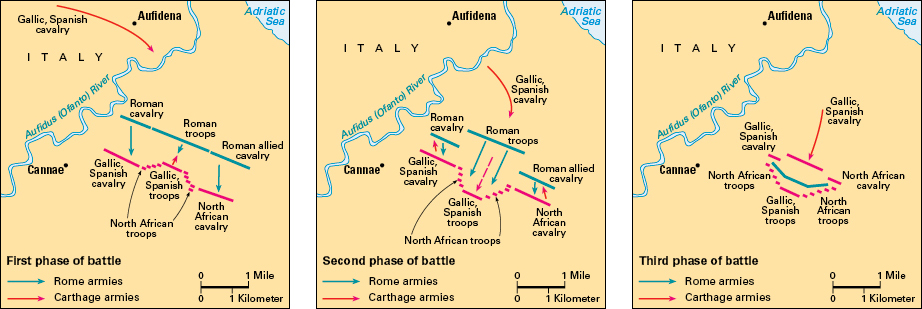Hannibal (247-183 B.C.) was the greatest general and statesman of Carthage, an ancient North African city. His excellent military strategy and leadership ability helped him overcome great handicaps and defeat armies much larger than his own. He united people of varied backgrounds under his command. Even under poor conditions, Hannibal’s army followed him with confidence.

His early life.
Hannibal was born in Carthage. His father, Hamilcar Barca, was also a military leader. Hamilcar Barca hated the Romans, his city’s chief enemy. According to tradition, Hamilcar made young Hannibal take an oath always to be an enemy of Rome. As a boy, Hannibal went with his father to Spain, a land partly ruled by Carthage. As a young man, Hannibal led troops against Spanish tribes, and helped increase Carthaginian power in Spain. Hannibal became the Carthaginian commander in Spain when he was 25 years old.
In the 220’s B.C., trouble developed between Carthage and Rome over Hannibal’s expansion. Hannibal attacked Saguntum, a Spanish city friendly to Rome, in 219 B.C. Rome declared war on Carthage–the Second Punic War–in 218 B.C.
His military campaigns.
Early in the war, Hannibal astonished the Romans with a daring maneuver. Starting from Spain with about 60,000 troops, he crossed the Pyrenees, France, and the Alps, and entered Roman Italy. Snow and cold, and fierce mountain tribes killed many Carthaginians in the Alps. Hannibal reached the Po Valley in northern Italy with only about 26,000 troops and 6,000 horses. He also brought a few elephants because they could sometimes shatter enemy lines, like tanks in modern battles. He then recruited 15,000 to 20,000 Gauls into his army. The Gauls, also called Celts, lived in the Po Valley and were enemies of Rome.
A Roman army brought up from Sicily tried to stop Hannibal’s advance. But Hannibal maneuvered the Romans into an ambush and defeated them in the Battle of the Trebia River. Hannibal moved on to central Italy in 217 B.C. There, he tricked a Roman army into following his army, and then destroyed the Romans in an ambush on the shores of Lake Trasimeno.

In 216 B.C., Hannibal found himself far outnumbered by the Romans at Cannae, in southern Italy. Hannibal arranged his troops in an arc. When the Romans attacked, the center of the formation retreated, and the two sides, with the help of Hannibal’s superior cavalry, encircled and crushed the Romans. The Carthaginians killed about 50,000 enemy troops in one day in the worst defeat ever suffered by a Roman army.
The turning point.
After Cannae, Hannibal’s future looked good. But the tide soon turned against him and Carthage. Hannibal had gained allies in southern Italy, in Macedonia, and in Syracuse, Sicily. But some of his allies became too busy with their own affairs to help him. The Romans still had many loyal allies and many troops of their own in central Italy, and were able to prevent reinforcements from reaching Hannibal.
Meanwhile, the Roman general Publius Cornelius Scipio drove the Carthaginians out of Spain, and in 204 B.C. invaded Africa. Hannibal was called home to Africa in 203 B.C. His army was finally defeated by Scipio at Zama, in northern Africa, in 202 B.C. The war ended in 201 B.C. with Rome the winner in spite of Hannibal’s great effort.
After the war.
Rome allowed Carthage to govern itself. Hannibal sometimes headed the government, and Carthage made a rapid recovery under his leadership. But he fled eastward in 195 B.C., after he heard the Romans were going to demand his surrender. He found protection with King Antiochus III of Syria, who was about to go to war with Rome. Antiochus made little use of Hannibal’s genius and lost the war in 189 B.C. Hannibal then fled to Bithynia, a country in what is now Turkey. When the Romans demanded his surrender, Hannibal committed suicide.
